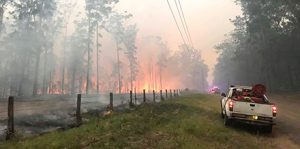Pressure is mounting on State governments to better manage national parks through hazard reduction burning and selective logging, to avoid a repeat of the bushfire crisis sweeping the nation. Fires yesterday in extreme conditions continued to threaten areas in south eastern NSW, eastern Victoria and Kangaroo Island. And it has already been reported that the NSW government will consider stripping land management and hazard reduction responsibilities from “conservationist” environmental agencies. Source: Timberbiz
The Federal Member for Gippsland Darren Chester has highlighted long-running calls from Gippsland locals for better forest management, including more hazard reduction burns. Mr Chester said now was not the time for a “blame game” with fires still active and communities vulnerable, but that he wanted to assure locals he was thinking about long term recovery and policy reforms.
But NSW Rural Fire Service Commissioner Shane Fitzsimmons says hazard reduction is important but not a panacea for bushfire risk.
He said hazard reduction burning was challenging and the biggest impediment to completing burns was weather. He said there was a “shrinking window of opportunity” for more favourable burning periods as fire seasons lengthened.
However, a Deloitte Access Economics report produced for the Australian Forest Products Association shows that the economic benefit of aggressive fuel load reduction massively outweighs the costs.
The report commissioned by AFPA in 2014, will help inform the current debate and provides factual information about the cost of undertaking preventative bushfire mitigation activities.
The report provides the background for undertaking a full Cost-Benefit Analysis (CBA) of a policy of greater use of fuel reduction burning in combination with the mechanical removal of trees and understorey biomass.
Chief Executive Officer of AFPA, Ross Hampton said that the magnitude of the bushfire tragedy including lost life, livelihoods and homes that is still unfolding on our east coast absolutely demands that when the rains finally come, we do not revert to business as usual.
“Surely we must no longer listen to those who say “protect“ the bush by locking it up and removing roads, people and machinery and instead look at ways to better manage our valuable forest assets,” Mr Hampton said.
“It’s clear that under many current forest policies, protected clearly means the opposite. A drying climate is making things worse but whatever policy makers do it this space will have no effect next summer or the one after.
“The only meaningful action we can take to make our communities safer is reduce fuel load especially around towns and key strategic locations.”
Mr Hampton said many experts have said this action is unaffordable, but this report proves that assertion wrong.
“It is important to note that this report also doesn’t take into account the fact that the by-product of using machines to thin forest is biomass which has a value. The operation could effectively pay for itself,” Mr Hampton said.
“But such work is meaningless if it is not done at a landscape scale. Those who say such activities must not occur in National parks or other reserves are turning their back on one of the only tools at our disposal to actually make a difference to their fire resilience.
“That’s why a National Royal Commission into bushfires and land management is vital.”
Former Victorian emergency management commissioner Craig Lapsley has also backed selective logging as a crucial fire-management tool.
The 2009 Black Saturday royal commission recommended that 5%of the state’s public land be burned each year to reduce fuel loads — a target that authorities struggled to meet.
Mr Lapsley, who was appointed to the post following the royal commission, said selective logging was a crucial fire-management tool.
“The silver bullet has to be more than just burning alone,” Mr Lapsley told The Australian.
“Thinning forests is a very divisive term and gets the environmentalists going nuts. But if you want to reduce the intensity of fires, you have to reduce the fuel. Thinning has to be a consideration.”
He said fuel reduction should be done in consultation with the local community and with respect for environmental values.






